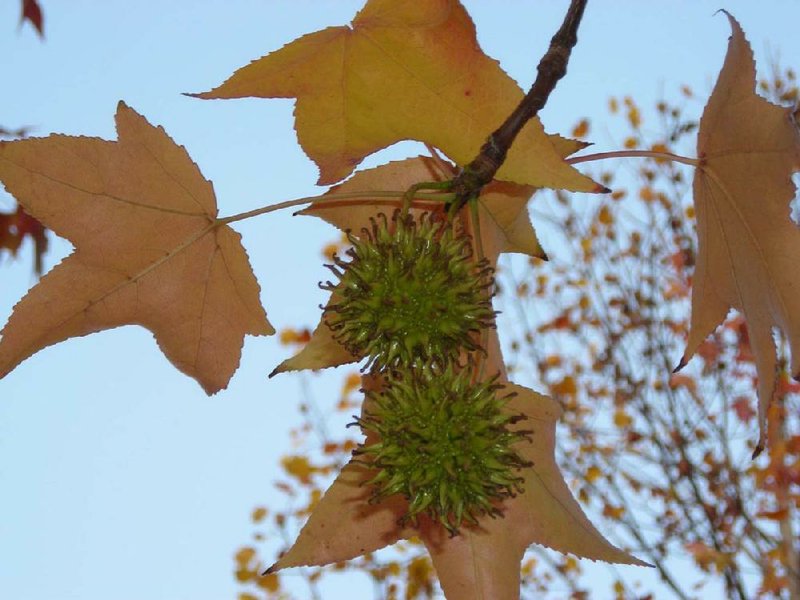LITTLE ROCK — In a recent column we discussed the merits of sweetgum trees - and the lack thereof. Here are two responses from readers:“I would suggest one other attribute of the sweetgum,” a reader wrote. “In 1953, when I attended the Boy Scout Jamboree in California, I took several sweetgum balls to trade with other Scouts for different items of equal value. I called these gum balls ‘porcupine eggs’ to suggest that porcupines grew in the forests of Oklahoma and Arkansas. One Scout from California traded me a block of California redwood with inscription and a clear finish.
We were both pleased with the trade.
“Since then, I have [urged] many kids that I have encountered in the woods to be on the lookout for porcupine eggs on the ground. I do have a certain degree of credibility since I have a degree in forestry from Oklahoma State University.
“No telling how many kids are still looking for porcupines in our forests.” Q Sweetgum trees have beautiful fall color and a pleasing shape, but oh, the plague of the sweetgum balls. Here’s my question/problem.
Ten years ago I bought a10-foot sweetgum tree from a nursery and was told it would not produce the dreaded gum balls. It didn’t for eight years, or if there were any, I sure didn’t notice them. Last year, for the first time, I noticed a few. This year, the darn things are all over the tree. How can a sweetgum tree go from being “gum-ball-less” to “gum-ballfull”?
A It has to be old enough to begin to bear fruit.
Most sweetgum trees will begin to bear at, on average, eight to 10 years, and will continue to produce the rest of their lives. There is a fruitless variety that has rounded lobes instead of the pointy ones of the fruited variety. Fruitless varieties are typically grafted trees, and if they are killed beneath the graft union, the root stalk is typically a common sweetgum and will bear fruit.
Q Our azaleas have scale.
We cannot get rid of it with regular sprays.
I started spraying in early spring, and no matter what, it got no better. What can we do?
A One thing to be aware of is that once you kill scale insects, the dead insects don’t vanish from the leaves they were feeding on, they are simply dead. You should see increased vigor in the plant and no new signs of scale on other foliage. Scale insects are called “scale” because they form an outer coating that acts as a shield or protection from contact insecticides and other predators. Typically we have to use a systemic insecticide that works from the inside out to control them. Orthene is one that is common;
another is imidacloprid, commonly called Merit or Bayer Advanced tree and shrub insecticide. An older formulation is dormant oil. It really doesn’t contain any chemicals, but it coats the stems and leaves and smothers out the scale. A downside of dormant oil is that you must get thorough coverage, which is difficult with an evergreen shrub.
Q I have a 10-year-old ficus tree indoors that is oozing and dripping a sticky substance on my floors. I suspect that it is caused by some sort of insect or parasite. It looks like it is very healthy and still putting out new leaves but the sticky stuff is quite a nuisance. Some leaves have small dark scale-type things on them. If this is the cause, is there anything I can do to rid my plant of them? I’ve tried spraying with insecticidal soap and removing what I see with rubbing alcohol. Maybe something systemic would work better?
A Your ficus tree could have scale, just like the azaleas in the earlier question, but ficus trees are also notorious for a process called guttation - where they basically sweat. They have built up too much moisture in their leaves and it has to come out somewhere. It typically occurs when there has been a major change in the plant’s environment, often when they are moved back indoors in the fall. They ooze excess moisture, typically out of the leaf where it is attached to the stem. It is very sticky, and it can stain, just like the honeydew that comes from sucking insects.
If you determine that sucking or scale insects are the culprit, there is systemic houseplant insecticide that comes in a pellet form of imidacloprid. You put the pellet into the soil and it slowly releases the insecticide and fertilizer to be absorbed by the root system. These pellets are safe to use indoors.
Janet Carson is a horticulture specialist for the University of Arkansas Cooperative Extension Service. Write to her at 2301 S. University Ave., Little Rock, Ark. 72204 or e-mail her at
HomeStyle, Pages 35 on 12/08/2012

